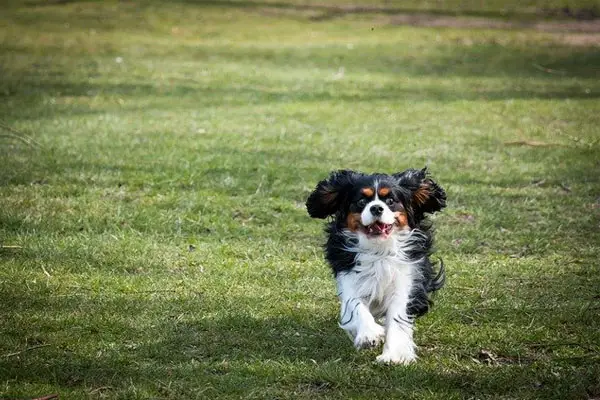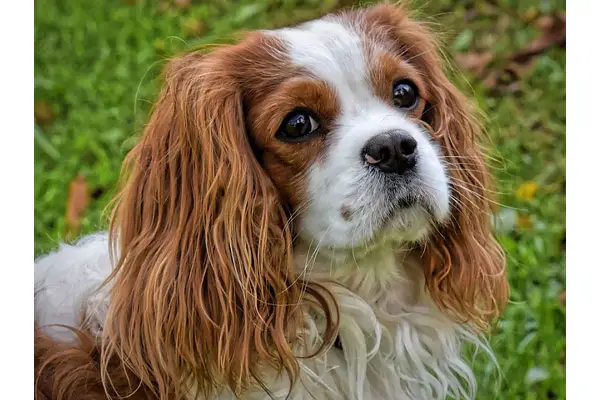Cavalier King Charles Spaniels, or Cavaliers for short, are toy dog breeds at only 13 inches in height, at most. The Cavalier King Charles Spaniel is known for having a sweet expression that matches their large and dark round eyes. Their long, silky coat is their ultimate feature, and this adds to their all-around beauty and sweetness.
Their overall appearance screams royalty. However, despite their small size and aristocratic background, they were able to retain the athletic nature of Spaniels. With their playful nature, they get along well with children and other dogs.
This dog breed is highly adaptive to any type of home situation and lifestyle. It’s an excellent home buddy whether you want to lay on your couch all day or you love athletic activities.

Cavalier King Charles Spaniel Statistics
| Dog Breed Group | Toy |
| Breed Size | Small |
| Height | 12-13 inches |
| Weight | 13-18 pounds |
| Lifespan | 12-15 years |
Cavalier King Charles Spaniel Ratings
| Energy level | |
| Exercise needs | |
| Requires attention | |
| Playfulness | |
| Trainability | |
| Shedding | |
| Grooming | |
| Friendly with family | |
| Friendly with kids | |
| Friendly with strangers | |
| Friendly with other dogs | |
| Prey Drive |
History Of The Cavalier King Charles Spaniel
The Cavalier King Charles Spaniels descended from the Toy Spaniel dog breed of the 17th century. Toy Spaniels have always been seen with nobles and royals. They were even drawn in the 16th, 17th, and 18th-century paintings of famous artists.
Among the royalties who loved the breed is Mary Queen of Scotts, who even had her Toy Spaniel accompany her during her execution. They are also the favorites of King Charles I and his son, King Charles II, where their name came. They were always seen with the King, and are even allowed to go into high-security areas. Some historians even say that the King was more focused on breeding more Spaniels.
When King Charles II died, the popularity of the breed started to decline, and pugs became the new favorite royalty dog breed.
Because of these, breeders started to breed the Cavalier King Charles Spaniel with these pugs, developing a shorter nose and domed head features. The breeding continued, but since there was no standard, the dog breed features varied, and most came with flat-face and undershot jaws. The original Cavalier King Charles Spaniel in paintings was almost extinct.
In the 1920s, an American named Roswell Eldridge started looking for the Spaniels depicted on the old paintings. He searched desperately for years until he offered a prize to breeders who could produce the breed, and they complied.
However, it was only in 1945 that the Cavalier King Charles Spaniel was finally recognized as a new breed by the Kennel Club. It was also during those times that two male Cavaliers were imported to the US.
However, there were a lot of processes that underwent until the American Kennel Club finally recognized the breed in March 1995.

Temperament
Cavalier King Charles Spaniels are best described as affectionate, gentle, and graceful. They are also referred to as sporting toy breeds because of their spaniel and toy traits combined.
They love people, even strangers, and they’re very dependent on companionship. They quickly become stressed if left alone too long. Separation anxiety is a problem also, so they are best with people who don’t get out of their house often. They are peaceful with other animals too, even with cats.
If you have kids, these Caliers make excellent playmates as well. Your kids can play ball with them, chase, teach them tricks, or cuddle. They can play well with toddlers, too, as long as you supervise. Since toddlers can get clumsy, you need to keep an eye and make sure they don’t accidentally fall on the Cavalier.
They tend to be manipulative by using their sweet round eyes. So, if you want to control their less desirable behaviors, then you need to work around these.
They are adorable, cute, and lovable, but they’re not perfect. They can be very stubborn and will bark a lot if bored or not trained.
Early socialization is highly needed to ensure only the proper behavior. Let him socialize with other people, other animals, see new sights, and enjoy their surroundings.
They are excellent pets for those who stay-at-home, work-at-home, or even if you love traveling. They can be the companion you need in whatever you need to do.
Care Requirements
- Nutrition: Cavalier King Charles Spaniels are prone to being overweight, so you need to watch their food intake. You also need to make sure that they eat a well-balanced diet with only high-quality ingredients. Their food must contain vitamins, minerals, carbohydrates, proteins, fats, and amino acids. Protein content will depend on your Cavelier’s activity. The less active, the lesser the protein content is. You can also add treats to their diet if you’re teaching them tricks to encourage them more into training. You should avoid foods containing corn, wheat, by-products, and chemical preservatives, as this may not be safe for your dog.
- Grooming: Cavalier King Charles Spaniel has a long and lustrous coat that needs regular brushing to maintain its condition. This will help keep it shiny and will get rid of any entanglements. For bathing, Cavaliers are usually clean dogs. You don’t need to bathe them if it’s not required. But if you need to wash them, make sure to use a shampoo that they won’t get allergic to. Check their ears and clean if needed to avoid any infection. Their nails should be trimmed, too, as this can cause pain.
- Exercise: Cavalier King Charles Spaniels are a combination of a sporting dog and a lap dog. They love taking walks and playing as much as they love staying on the couch, cuddle up. If you wish to give them an exercise, one hour of daily walks will do. If you don’t want to take them walking, you can at least let them play other activities so that they get entertained. You can train them as well to stimulate their minds. Just make sure that you keep them on a leash if you’re outside as they tend to wander off around. If you’ll let them loose, it needs to be in a fenced area.
- Health: The Cavaliers have a fairly long life expectancy. They are generally healthy but may be prone to health problems. Major health issues they are prone to are syringomyelia, mitral valve disease, and hip dysplasia, while minor health issues are patellar luxation and entropion. Regular check-ups are needed to ensure your Cavalier’s health stays at its best. You can also ask to get some screen tests so you can rule out other health conditions.
- Lifespan: The life expectancy of Cavalier King Charles Spaniels is 12-15 years.

Famous Cavalier King Charles Spaniels
- Rogue: King Charles I Spaniel who accompanied him to his execution
- Dash: Queen Victoria’s Cavalier Spaniel
- Rex: President Ronald Reagan’s Cavalier King Charles Spaniel
- Rowley: The Cavalier King Charles Spaniel of Princess Margaret, Queen Elizabeth II’s sister
Fun Facts About Cavalier King Charles Spaniels
- Cavalier King Charles Spaniels were bred from the Toy Spaniels.
- King Charles II named the breed.
- They were royalties. King Charles II had given them access to high-security places.
- Cavaliers come in four colors, each with unique names – Prince Charles (tri-color), King Charles (black and tan), Ruby (mahogany), and Blenheim (chestnut and white).
- They are also called “The Comforter Spaniels” because they make excellent lap dogs.
- They were first recognized as a breed by the AKC in 1995 (though they’ve existed for centuries).
- Royalties and Celebrities love them.
Check Out Other Toy Dog Breeds:
Affenpinscher, Brussels Griffon, Chihuahua, Chinese Crested, English Toy Spaniel, Havanese, Italian Greyhound, Japanese Chin, Maltese, Miniature Pinscher, Papillon, Pekingese, Pomeranian, Pug, Shih Tzu, Silky Terrier, Toy Fox Terrier, Yorkshire Terrier
